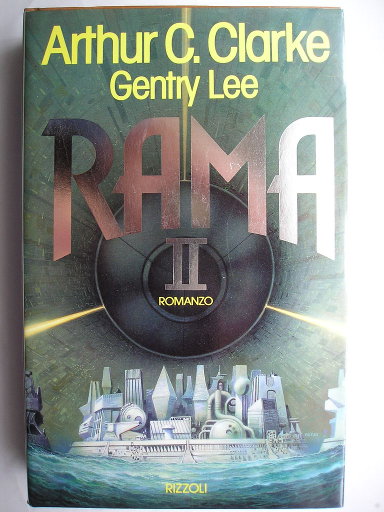
The novel “Rama II” by Arthur C. Clarke and Gentry Lee was published for the first time in 1989. It’s the sequel of “Rendezvous with Rama“.
Seventy years after the passage of the alien spaceship called Rama, another one that looks identical gets spotted. Despite the terrible global economic crisis of the previous decades led to sharp cuts in space exploration, an expedition is set up to go and try to find out the secrets of what gets called Rama II.
The Rama II exploration mission’s crew members are supposed to be professionals focused on scientific research. Instead, some of them show soon they have secret agendas and ambitions that interfere with the research. Some events that may or may not be accidents further threaten the expedition.
Arthur C. Clarke wrote “Rendezvous with Rama” as a self-contained novel but his encounter with Gentry Lee changed that starting the last phase of his career, made of collaborations. In these new works Clarke mostly supplied ideas leaving the actual work of writing especially to his colleague even if on book covers his name was written in a larger font for advertising reasons.
One of the first collaborations between Arthur C. Clarke and Gentry Lee was the transformation of the novel “Rendezvous with Rama” into a series. “Rama II” is the first sequel that begins about seventy years after the original story so in theory you can start from the second novel, although it’s a shame to miss the first.
“Rama II” begins with an update on what happened in the decades between the passage of the first alien spacecraft in the solar system and the sighting of the second. You can see immediately a significant change of tone because the typical Arthur C. Clarke’s science fiction was marked by a degree of optimism and progress while in this novel we see essentially the opposite.
In the 22nd century Earth was hit by a terrible economic crisis that led to an almost total abandonment of space colonies and stations. In many ways, this is what happened in the last few years so today the start of “Rama II” shows elements all too familiar.
At the end of 22nd century, only a few scholars are still interested in Rama, the alien spaceship passed through the solar system in the previous century. Everything changes when another one that looks identical gets spotted. An expedition is set up to go and explore the second spaceship and the readers may fear they’re reading a copy of “Rendezvous with Rama” but “Rama II” confirms it’s very different from the first novel.
Gentry Lee has a scientific and technical background like Arthur C. Clarke with years of work at NASA’s Jet Propulsion Laboratory (JPL) but his style is very different from his colleague’s. In “Rama II” that can be noticed for much greater attention paid to the characters. Unfortunately, the way it was handled in my opinion becomes more a flaw then a a merit.
“Rendezvous with Rama” was the exploration history of a mysterious alien spacecraft accomplished by very competent people focused on their work. “Rama II” is the story of people who often have personal ambitions and agendas that come first and the exploration of the second spaceship is a means to gain advantage for themselves.
In “Rama II” the characters are much more developed than in the first novel and in principle it would be fine to me. The problem is the fact that these developments include soap opera elements, in particular in Nicole des Jardins’ story and certain events seem to have the only purpose to force the clashes within the expedition.
The impression I had too often reading “Rama II” is that within the expedition there were a few amateurs chosen only for political reasons. Their skills are mentioned but their behavior is unprofessional and sometimes is criminal. The consequence is that instead of having the exploration of an alien artifact the story often focuses on the relationships among the expedition members and in particular on their clashes.
It’s a shame because “Rama II” contains interesting elements as the second alien spacecraft is identical to the first but there are also several different developments. In essence, there was all that was needed to build an intriguing story but too often in my opinion the plot gets wasted between soap opera elements and clashes among the characters.
The last part of the novel consists of a crisis in which the various characters act according to whether they think about their own personal interests or with broader motivations. There are interesting ethical and moral considerations largely developed as religious motivations and I think that ends up being a limit but I realize that in this case the reactions are very personal.
The result is a mix-up that sometimes I found frustrating when the elements I was interested in were overshadowed by others that seemed unnecessary. “Rama II” has its end but lays the foundation for the third novel in the series so you can read it and decide for yourself whether you like its tone or not. In the end I found it overall decent but nothing more, with more flaws than merits.


Permalink
Permalink